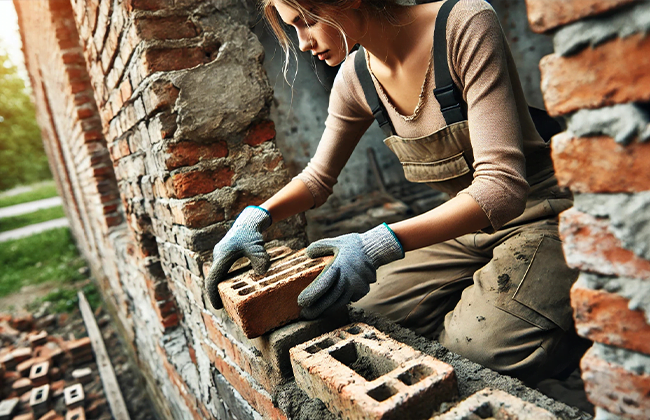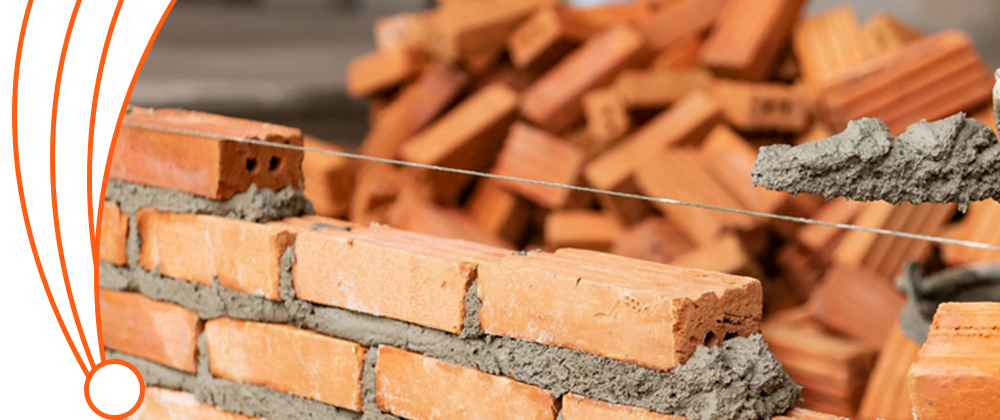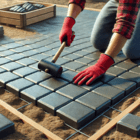Replacing damaged bricks is crucial for maintaining the structural integrity and aesthetic appeal of your building. Whether you’re dealing with weather effects, accidental impacts, or general deterioration over time, understanding how to replace damaged bricks can save you from costly repairs in the future. This guide covers everything from the initial assessment of damage to the innovative solutions that can make brick replacement more effective and sustainable.
Table of Contents
What Causes Brick Damage?
Brick damage can arise from a variety of sources, fundamentally undermining the structure and appearance of your building. Let’s delve into the primary causes:
1. Weather Effects
The elements are not always kind to bricks. Regular exposure to rain, snow, and sun can erode even the strongest materials. Bricks are porous, so they absorb moisture, which can expand in cold weather and crack the brick as it freezes. During hot weather, this moisture evaporates, further stressing the material. This cycle of absorption and evaporation can lead to significant deterioration over time.
2. Impact from Accidents
Sometimes, external forces can damage bricks. Whether it’s a wayward car bumping into a wall or a heavy object striking the surface, these impacts can cause immediate and visible damage. Cracks, chips, or even whole bricks may become dislodged. Such incidents not only mar the appearance of a brick wall but can also compromise its structural integrity.
3. Deterioration Over Time
Like all building materials, bricks wear down with age. Environmental pollutants, poor construction, or lack of maintenance can accelerate this process. Over time, the mortar may crumble, and bricks may start to spall or lose their face. This weakening is gradual but can eventually lead to the need for substantial repairs or total replacement.
Given these factors, recognizing and addressing brick damage early is essential to maintaining the integrity and safety of a structure. Next, we will explore how to properly assess brick damage, ensuring that any issues are caught and corrected promptly.
How to Assess Brick Damage
To effectively assess brick damage, it’s important to employ a systematic approach that combines both direct observation and the use of specialized tools to ensure a thorough examination.
Visual Inspection Techniques
Start your assessment with a careful visual inspection of the brickwork. Look for obvious signs of deterioration such as cracks, chips, and areas of discoloration. Pay particular attention to the mortar joints, as damage here can also indicate underlying issues. Focus on areas prone to moisture, as these are more susceptible to damage. This initial scan helps identify visible problems and areas that may require a more detailed investigation.
Using Tools to Assess Damage
For a deeper insight into the condition of the bricks, use diagnostic tools. A moisture meter can be invaluable in detecting the levels of moisture within the bricks, which is a common cause of damage. Moisture within the structure can lead to freezing and thawing cycles that exacerbate cracks and structural weakening. Additionally, employing a borescope can allow for a non-invasive look into the internal structure of the wall, revealing hidden cracks or voids that are not visible on the surface.
Professional Evaluation
If the visual and tool-assisted assessments suggest significant damage, or if you are unsure of your findings, consulting with a professional is advisable. A structural engineer or a specialized brick inspector can offer a more comprehensive evaluation. They can assess the structural integrity of the brickwork and provide detailed advice on necessary repairs or replacements. Their expertise ensures that all safety and durability aspects of the structure are adequately addressed.
By combining these methods, you can gain a clear understanding of the condition of your brickwork and make informed decisions on how to proceed with maintenance or repairs. This detailed approach is crucial in preserving the longevity and safety of your property. With a thorough assessment completed, you are now well-prepared to determine when and why brick replacement might be necessary, ensuring that your repair efforts are timely and effective.
When Do You Need Brick Replacement?
Determining when to replace bricks is crucial for maintaining both the appearance and structural integrity of your building. Here’s how you can identify the right time for a brick replacement:
Signs that Indicate Immediate Replacement is Necessary
Immediate action is required when bricks show signs of significant structural damage. Look for deep cracks that spread across multiple bricks, loose or missing bricks, and extensive spalling where the brick’s surface has flaked away to expose its inner materials. These symptoms indicate a serious compromise to the wall’s integrity and necessitate quick replacement to prevent further damage and ensure safety.
Long-Term Damage that Requires Intervention
Brick damage can also accumulate gradually and may not demand urgent action but still needs attention. This includes the slow deterioration of mortar, minor spalling, and the development of small cracks. Addressing these issues early through repair can often prevent the need for more comprehensive replacements later. Neglecting these signs, however, can lead to significant structural issues that might require extensive and costly interventions.
Assessing the Urgency of Brick Replacement
To assess how urgently you need to replace damaged bricks, consider the damage’s scope and location. Structural walls, which bear loads, should be prioritized due to their critical role in maintaining building stability. Additionally, factors like moisture presence and the rate of deterioration are vital in determining the replacement urgency. Consulting with a professional can offer a detailed evaluation, helping you prioritize repairs based on immediate risks and potential future problems.
Identifying the need for brick replacement at the right time is essential to prevent safety hazards and maintain your property’s structural integrity. With a clear understanding of the signs and conditions that warrant brick replacement, you can proceed confidently with the necessary repairs or replacements, guided by the upcoming step-by-step guide on how to replace damaged bricks.
Step-by-Step Guide: How to Replace Damaged Bricks
Replacing damaged bricks is a meticulous process that requires the right tools and techniques. Here’s how to ensure the repair enhances both the durability and appearance of your brickwork:
1. Necessary Tools and Materials
Before you begin, gather all necessary tools and materials to make the job smoother. You’ll need:
- A chisel and hammer for removing the damaged brick.
- A trowel for applying new mortar.
- Mortar mix to secure the new brick in place.
- A stiff brush for cleaning out the old mortar.
- Safety goggles and gloves to protect yourself during the process.
2. Removing the Damaged Brick
Start by carefully chiseling out the mortar around the damaged brick. Take your time to avoid damaging the surrounding bricks. Once the mortar is loose, gently tap the brick with your hammer until it can be removed. Clear out any remaining mortar and debris from the cavity with your brush, ensuring a clean space for the new brick.
3. Preparing the Space for a New Brick
Prepare your mortar mix according to the manufacturer’s instructions. Apply a generous amount of mortar to the cavity, making sure to press it into the back and sides. This base of mortar will support the new brick and help it adhere properly.
4. Installing the New Brick
Slide the new brick into place, pressing it firmly into the mortar. Ensure it is aligned with the surrounding bricks for a uniform look. Add more mortar around the edges, then use your trowel to scrape off any excess and smooth the surface.
5. Sealing and Finishing Touches
Once the brick is installed and the mortar has begun to set, use a jointer tool to create a clean, concave finish on the mortar lines. This not only improves the wall’s appearance but also helps in weatherproofing the repair. Allow the mortar to cure as per the guidelines before exposing it to any significant weather conditions.
With these steps, you can replace damaged bricks effectively, restoring the structural integrity and aesthetic value of your wall. Now that you know how to replace damaged bricks efficiently, the next logical step is to understand the costs involved in such repairs, which we will cover in the upcoming section on the cost to replace damaged bricks.
Cost to Replace Damaged Bricks
Evaluating the costs associated with replacing damaged bricks is essential for proper budgeting and deciding between a DIY project or hiring a professional. Several factors influence the overall expenses, ranging from the type of materials used to the location of the repair.
Factors Influencing Cost
- Type of Brick: Specialty bricks can be more costly than standard ones due to their unique characteristics or higher quality.
- Extent of Damage: The more extensive the damage, the more materials and time are needed, increasing the costs.
- Accessibility: Difficult-to-reach areas may require special equipment or extra labor, driving up costs.
- Location: Prices can vary significantly across different regions due to variations in labor rates and the availability of materials.
Average Costs for DIY vs. Professional Repair
Here’s a comparative table to give you a clear picture of the potential costs associated with DIY versus hiring professionals:
| Type of Cost | DIY | Professional |
| Materials | $50 – $100 (depending on the number of bricks and type of mortar) | Included in service |
| Tools (if not owned) | $30 – $100 (one-time purchase for basic masonry tools) | N/A |
| Labor | Free (your own time) | $300 – $800 (depending on the scope and complexity of the job) |
| Total Estimated Cost | $80 – $200 | $300 – $900 |
These estimates are guidelines and can fluctuate based on specific project details. While DIY projects can save money on labor, they require a time commitment and the potential purchase of tools. On the other hand, professional services, though more costly, ensure expert quality and often come with guarantees.
Considering these factors is not only about addressing immediate repairs but also about planning for the ongoing maintenance of your brickwork to mitigate future issues. Proper ongoing care helps prolong the lifespan of your brick structures, reducing the likelihood and cost of future repairs, which seamlessly leads into our next topic of maintaining your brickwork effectively.
Maintaining Your Brickwork

Keeping your brickwork in top condition is not just about aesthetics; it’s crucial for ensuring the longevity and safety of your building. Here’s how you can maintain your bricks effectively:
Regular Maintenance Tips
- Cleaning: Regularly clean your bricks to remove dirt, debris, and biological growth like moss or algae, which can retain moisture and degrade the material over time. Use a soft brush and, if necessary, mild cleaning solutions suitable for bricks.
- Inspection: Conduct semi-annual inspections of your brickwork to catch early signs of damage such as cracks or mortar deterioration. Early detection means simpler, more cost-effective repairs.
- Repointing: Over time, mortar may crack or erode. Repointing—removing old mortar and replacing it with new mortar—is essential to prevent water from seeping behind the bricks, which can lead to serious structural issues.
Preventative Measures to Avoid Future Damage
- Waterproofing: Applying a breathable waterproofing sealant can help prevent water ingress, a common cause of brick damage. Ensure the sealant is suitable for brickwork to avoid trapping moisture inside the bricks.
- Proper Drainage: Ensure that your property has effective drainage systems to keep water away from brick structures. Proper gutters, downspouts, and drainage channels will divert water, reducing the risk of water damage.
- Avoiding Physical Damage: Protect brickwork from potential impacts from vehicles, garden equipment, or during other construction activities around your property.
By following these maintenance and preventative strategies, you can significantly extend the life of your brickwork and minimize the need for extensive repairs. As we look to the future, it’s also worth considering innovative repair solutions that can offer more durable, efficient, and aesthetically pleasing results, which will be covered in the upcoming section on innovative repair solutions.
Innovative Repair Solutions
As technology advances, so do the methods we use to repair and maintain brickwork. These innovative solutions not only enhance the durability and appearance of brick structures but also streamline the repair process.
Latest Techniques in Brick Replacement
- 3D Printed Bricks: One of the most cutting-edge developments in brick replacement is the use of 3D printing technology. Custom bricks can be printed to match the exact size and color of existing bricks, ensuring a seamless integration into the wall without compromising the aesthetic continuity.
- Mortar Injection Techniques: New mortar injection methods allow for stronger, deeper penetration of mortar into cracks and voids. This technique improves the bond between existing bricks and the new mortar, enhancing structural integrity without extensive disassembly.
How Technology is Changing Brick Repair
- Digital Mapping and Analysis: Drones and imaging software are now used to assess and map the condition of brickwork in high detail. These tools can identify issues that are not visible to the naked eye, enabling targeted repairs that are both effective and less intrusive.
- Advanced Material Composition: The development of new materials, such as polymer-modified mortars and eco-friendly, breathable sealants, provide better protection against moisture and environmental decay. These materials help ensure that repairs last longer and bricks are better preserved against future damage.
Adopting these innovative repair solutions not only enhances the efficacy of repairs but also extends the lifespan of brick structures. With technology continually evolving, the future of brick repair looks promising, offering more efficient, effective, and sustainable options for maintaining our buildings.
Conclusion
Replacing damaged bricks is essential not only for the aesthetic appeal of your property but also for its structural integrity. Using the right techniques and materials can significantly extend the lifespan of your walls and prevent future damage. If you’re looking for professional contractors to replace damaged bricks, consider contacting our recommended experts at (+1) 917-355-8556 for reliable and efficient service.
FAQs
Q: What are the signs that I need to replace damaged bricks?
A: The signs include visible cracks, loose bricks, and deterioration of the mortar. These indicators suggest that the bricks may no longer provide the necessary structural support and aesthetic value.
Q: How often should I inspect my property for damaged bricks?
A: It’s wise to inspect your property at least twice a year. Regular inspections help catch potential issues early, reducing the need for extensive replacements.
Q: What tools are necessary to replace damaged bricks?
A: Essential tools include a chisel, hammer, trowel, mortar mix, and a stiff brush for cleaning. These tools help ensure that the replacement process is smooth and effective.
Q: Can I replace damaged bricks myself, or should I hire a professional?
A: For minor repairs, a DIY approach might be sufficient. However, for extensive damage or structural repairs, hiring a professional is recommended to ensure safety and quality.
Q: What innovative solutions are available for replacing damaged bricks?
A: Recent innovations include 3D printed bricks and advanced mortar injection techniques, which provide stronger repairs and a more seamless match with existing brickwork.
Q: Can damaged bricks be repaired?
A: Yes, in many cases, damaged bricks can be repaired as part of the process of replacing damaged bricks. This can involve re-mortaring or filling minor cracks to restore the brick’s appearance and functionality.
Q: How to replace a broken brick?
A: When replacing damaged bricks, start by carefully removing the broken brick and clearing out old mortar. Apply fresh mortar to install a new brick, ensuring you place it securely and align it with the surrounding bricks.
Q: Should cracked bricks be replaced?
A: You should typically replace cracked bricks to maintain the structural integrity of the wall. Replacing damaged bricks helps prevent further deterioration and potential water damage.




